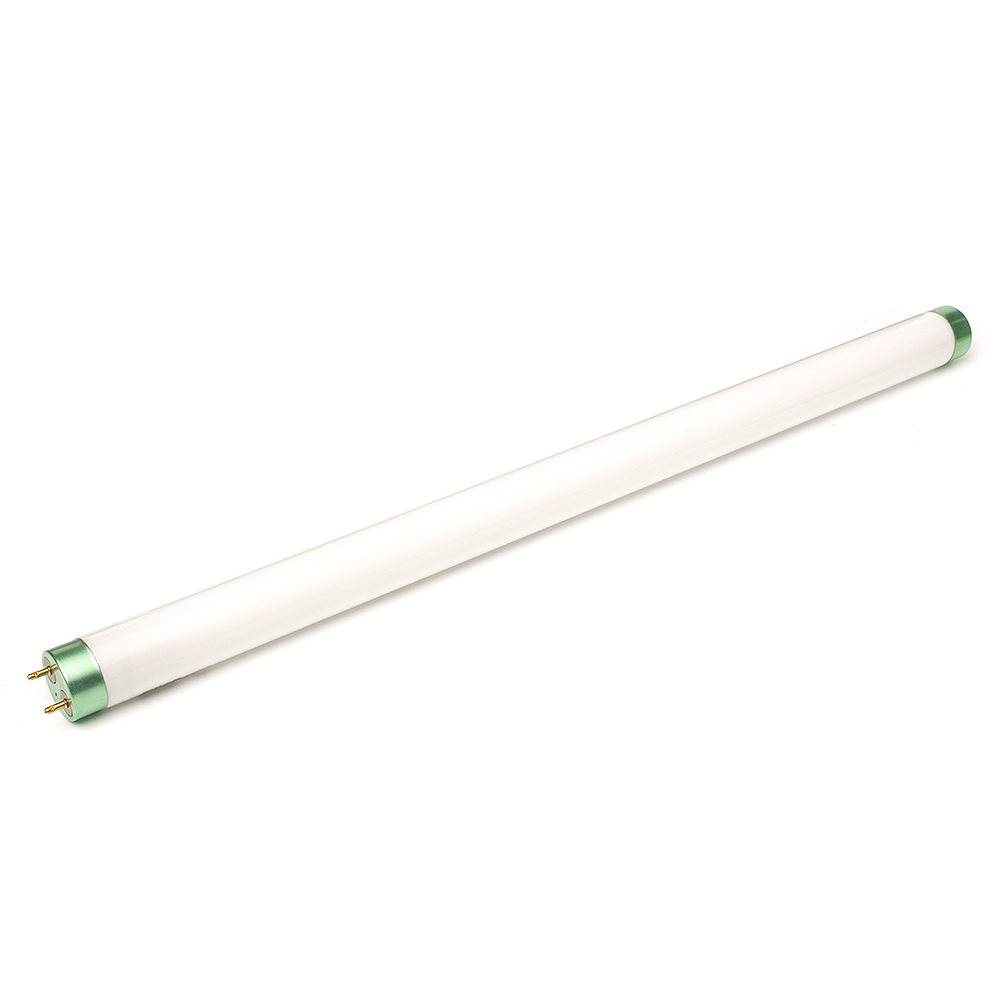Home 15W F15T8/BL Long Crack Ultraviolet Bulb – 15″ – UV Lamp
$10.00
In Stock
This 365nm white ultraviolet bulb fits the following Delta Kits UV curing lamps:
15045 12V 15W Long Crack UV Curing Lamp
15050 120V 15W Long Crack UV Curing Lamp
15055 240V 15W Long Crack UV Curing Lamp
Replaces Part Number: 40-4A
The EIKO 15W F15T8/BL fluorescent bulb is optimized for ultraviolet output at 350-365 nanometers, a wavelength within the UVA black light spectrum. This 15 watt lamp results in 2.6 watts of ultraviolet at the target wavelength. The bulb is 18 inches long with a 1-inch diameter and a G13 medium bi pin base. Applications for the 15W F15T8/BL include insect traps, photography and resin curing.
This white bulb fits the following Delta Kits UV curing lamps:
15045 12V 15W Long Crack UV Curing Lamp
15050 120V 15W Long Crack UV Curing Lamp
15055 240V 15W Long Crack UV Curing Lamp
Replaces Part Number: 40-4A
Description 15W Black Light UVA T-8 G13 Base
UPC: 03129315526
From the Archives
Is the crack volatile? How long has it been there? Is it moving?
The best way to remove moisture from the crack in the glass is with heat. So, although I prefer not to submit long cracks to drastic temperature changes I do heat cracks to remove moisture. The important thing to remember here is that you want to warm the glass slowly. If at all possible, warm the entire windshield. Once the glass is warm, use a heat gun or a torch to dry out the break.
CAUTION: This is not for the faint of heart. As most of you know I am not a big fan of using a torch or heat gun on damaged glass, but when it comes to long cracks moisture evaporators just don’t always cut it. However, using a torch or heat gun greatly increases the chance of a crack out, so I strongly suggest that you only use those methods if you have practiced this technique at least a couple of dozen times.
If the crack moves when you apply light pressure near the end or if the customer tells you it has moved within the last few days, I recommend drilling the end and popping a small bullseye at the end with a Delta Kits Slide Hammer. I also recommend drilling any crack over 3″ long as a precautionary measure.
If the windshield is 70 degrees F or above and there is no water in the crack I would not heat the glass. In fact, if the crack does not stem from a star or combination break that will also need to be filled I would not warm the glass unless it was under 60 degrees F. The reason for this is that as the glass is warmed it expands and if warmed too much the crack may expand and make injecting resin more difficult.
If you do have to warm the glass, do so slowly as stated above. Defrosters work well if you can run the vehicle during the repair process, but you should also warm the outside of the glass whenever possible. Generally, I like using a hair dryer for warming a break, but when dealing with long cracks I prefer using heat lamps or an electric blanket draped across the glass. This allows you to warm the glass slowly and keep it warm during the repair process. However, I must admit that I don’t typically carry an electric blanket or heat lamps. In most cases, I end up positioning my hair dryer to blows warm air across the crack during the repair. Warm the glass before starting the repair and do not apply spot heat to a long crack during the pressure cycle.
I don’t typically use crack expanders unless I expect to have a troublesome spot in a crack. If you have drilled the end of the crack, popped a bullseye and warmed the glass, you may place a crack expander every 6″. Carefully apply light pressure. If the crack has partially closed due to the warming process, the crack expander will open it back up. Making filling with resin easier. Be prepared to remove crack expanders quickly if the crack moves past the termination point. Otherwise, leave them on until the crack is completely filled with resin and then remove them just before curing.
Important things to remember when filling long cracks regardless of weather conditions.
Only logged in customers who have purchased this product may leave a review.
This windshield repair training is a hands-on, intensive, one day course designed to take your repair quality to the next level. Whether you are just starting out or are a seasoned pro, this class is right for you!
Our team of experienced technicians are dedicated to offering the highest standard of training in the windshield repair industry. During the Delta Kits Training and Certification course, technicians are trained to follow ROLAGS (Repair of Laminated Auto Glass Standards), the industries best practices. Delta Kits Training and Certification covers all technical aspects of windshield repair and will take you from never having completed a repair, to being among the best technicians in the industry. The marketing and insurance billing discussion is designed to help you become more successful in your windshield repair business.

Brent Deines was originally trained by a Novus Methodman in 1987 and is NWRA certified. He has extensive experience repairing windshields and restoring headlights in a variety of climates and conditions. Deines has owned several auto glass repair and replacement businesses in Montana and Oregon and is currently the President and CEO of Delta Kits where he helped develop the company’s headlight restoration program and started the company’s windshield repair training and certification program in 1995.

Korey Gobin, Delta Kits sales manager, is NWRA certified and has been training individuals as well as large groups in the art of professional windshield repair and headlight restoration since 2008. Gobin is actively involved in the Repair of Laminated Automotive Glass Standard and in 2011 was awarded the Mobile Tech Windshield Repair Person of the Year. Korey serves on the ROLAGS committee and has traveled extensively throughout the USA, Canada, and Mexico to promote high-quality standards for windshield repair and headlight restoration. He is affectionately known by his customers as the “Go to Guy” for windshield repair.

Graham Watson, is one of the original Novus Technicians in the UK since 1988 and since then has been running a very successful windscreen repair service in the UK. In 2008 Graham was named Windshield Repair Person of the year at the Mobile Tech Expo, an award he is very proud of as it is voted for by his peers in the trade. For the past 10 years, Watson has been active training technicians for the repair industry and specializes in advanced training for techs with previous experience, during this time he has been lucky enough to work with people from many different countries. His passion for helping others carry out the best quality repairs possible shows in the time he spends offering advice on different trade forums as Screenman.
The EIKO 15W F15T8/BL fluorescent bulb is optimized for ultraviolet output at 350-365 nanometers, a wavelength within the UVA black light spectrum. This 15 watt lamp results in 2.6 watts of ultraviolet at the target wavelength. The bulb is 18 inches long with a 1-inch diameter and a G13 medium bi pin base. Applications for the 15W F15T8/BL include insect traps, photography and resin curing.
This white bulb fits the following Delta Kits UV curing lamps:
15045 12V 15W Long Crack UV Curing Lamp
15050 120V 15W Long Crack UV Curing Lamp
15055 240V 15W Long Crack UV Curing Lamp
Replaces Part Number: 40-4A
Description 15W Black Light UVA T-8 G13 Base
UPC: 03129315526
From the Archives
Is the crack volatile? How long has it been there? Is it moving?
The best way to remove moisture from the crack in the glass is with heat. So, although I prefer not to submit long cracks to drastic temperature changes I do heat cracks to remove moisture. The important thing to remember here is that you want to warm the glass slowly. If at all possible, warm the entire windshield. Once the glass is warm, use a heat gun or a torch to dry out the break.
CAUTION: This is not for the faint of heart. As most of you know I am not a big fan of using a torch or heat gun on damaged glass, but when it comes to long cracks moisture evaporators just don’t always cut it. However, using a torch or heat gun greatly increases the chance of a crack out, so I strongly suggest that you only use those methods if you have practiced this technique at least a couple of dozen times.
If the crack moves when you apply light pressure near the end or if the customer tells you it has moved within the last few days, I recommend drilling the end and popping a small bullseye at the end with a Delta Kits Slide Hammer. I also recommend drilling any crack over 3″ long as a precautionary measure.
If the windshield is 70 degrees F or above and there is no water in the crack I would not heat the glass. In fact, if the crack does not stem from a star or combination break that will also need to be filled I would not warm the glass unless it was under 60 degrees F. The reason for this is that as the glass is warmed it expands and if warmed too much the crack may expand and make injecting resin more difficult.
If you do have to warm the glass, do so slowly as stated above. Defrosters work well if you can run the vehicle during the repair process, but you should also warm the outside of the glass whenever possible. Generally, I like using a hair dryer for warming a break, but when dealing with long cracks I prefer using heat lamps or an electric blanket draped across the glass. This allows you to warm the glass slowly and keep it warm during the repair process. However, I must admit that I don’t typically carry an electric blanket or heat lamps. In most cases, I end up positioning my hair dryer to blows warm air across the crack during the repair. Warm the glass before starting the repair and do not apply spot heat to a long crack during the pressure cycle.
I don’t typically use crack expanders unless I expect to have a troublesome spot in a crack. If you have drilled the end of the crack, popped a bullseye and warmed the glass, you may place a crack expander every 6″. Carefully apply light pressure. If the crack has partially closed due to the warming process, the crack expander will open it back up. Making filling with resin easier. Be prepared to remove crack expanders quickly if the crack moves past the termination point. Otherwise, leave them on until the crack is completely filled with resin and then remove them just before curing.
Important things to remember when filling long cracks regardless of weather conditions.
There are no reviews yet.
Only logged in customers who have purchased this product may leave a review.
This windshield repair training is a hands-on, intensive, one day course designed to take your repair quality to the next level. Whether you are just starting out or are a seasoned pro, this class is right for you!
Our team of experienced technicians are dedicated to offering the highest standard of training in the windshield repair industry. During the Delta Kits Training and Certification course, technicians are trained to follow ROLAGS (Repair of Laminated Auto Glass Standards), the industries best practices. Delta Kits Training and Certification covers all technical aspects of windshield repair and will take you from never having completed a repair, to being among the best technicians in the industry. The marketing and insurance billing discussion is designed to help you become more successful in your windshield repair business.

Brent Deines was originally trained by a Novus Methodman in 1987 and is NWRA certified. He has extensive experience repairing windshields and restoring headlights in a variety of climates and conditions. Deines has owned several auto glass repair and replacement businesses in Montana and Oregon and is currently the President and CEO of Delta Kits where he helped develop the company’s headlight restoration program and started the company’s windshield repair training and certification program in 1995.

Korey Gobin, Delta Kits sales manager, is NWRA certified and has been training individuals as well as large groups in the art of professional windshield repair and headlight restoration since 2008. Gobin is actively involved in the Repair of Laminated Automotive Glass Standard and in 2011 was awarded the Mobile Tech Windshield Repair Person of the Year. Korey serves on the ROLAGS committee and has traveled extensively throughout the USA, Canada, and Mexico to promote high-quality standards for windshield repair and headlight restoration. He is affectionately known by his customers as the “Go to Guy” for windshield repair.

Graham Watson, is one of the original Novus Technicians in the UK since 1988 and since then has been running a very successful windscreen repair service in the UK. In 2008 Graham was named Windshield Repair Person of the year at the Mobile Tech Expo, an award he is very proud of as it is voted for by his peers in the trade. For the past 10 years, Watson has been active training technicians for the repair industry and specializes in advanced training for techs with previous experience, during this time he has been lucky enough to work with people from many different countries. His passion for helping others carry out the best quality repairs possible shows in the time he spends offering advice on different trade forums as Screenman.

$10.00
1090 Bailey Hill Rd, Ste A
Eugene, OR 97402
sales@deltakits.com
Reviews
There are no reviews yet.